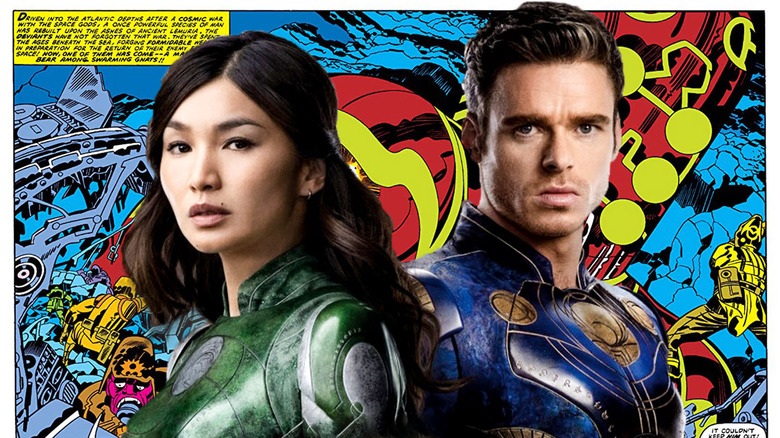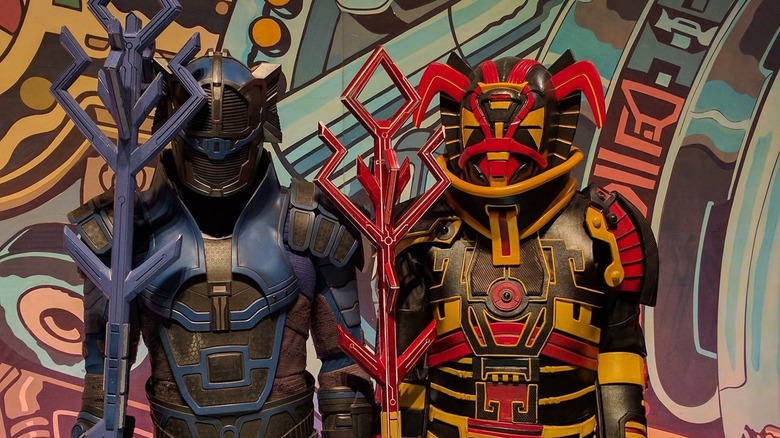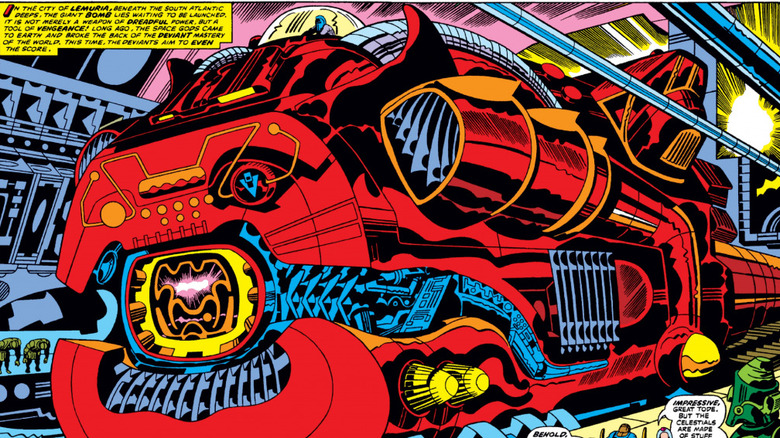How Eternals Fails To Live Up To The Potential Of Jack Kirby
There's no getting around it: Marvel Studios' new film "Eternals" is a weird movie. Not just weird compared to other Marvel Cinematic Universe movies, but compared to all movies that came before or since. It contains rapid-fire tonal shifts that make your head spin, jumping from light comedy to action to cosmic sci-fi and back again seemingly without blinking. The film slings strong themes we're not used to seeing in a PG-13 superhero flick, things like sex (and sexual identity), suicide, and the futility of being. Oscar-winning "Nomadland" director Chloé Zhao clearly was making some big swings with this one, and even though the critical response has been mixed – largely because "Eternals" is too much of an outlier — we're making a different supposition: It wasn't weird enough.
Specifically, the film did not live up to the legacy of Jack Kirby, whose artistic sensibilities by the time he created "The Eternals" in 1976 had reached their abstract, near-cubist height. This leaves us wondering why the "Eternals" movie can at times feel so pedestrian while also being so singularly strange?
The Ragnarok Factor
When you really get down to it, the true disappointment in the "Eternals" movie failing to carry through with Kirby's more bonkers visuals is that another Oscar-caliber filmmaker already proved you can do it: Taika Waititi. The filmmaker behind 2017's "Thor: Ragnarok" went to great lengths to capture the legendary artist's chunky, geometrical aesthetic in the world of Sakaar so that fans could finally see what it would look like to have Kirby's worlds translated literally to the screen. When "Eternals" was first announced the following April after that film's success, it seemed like series producer Kevin Feige was ready to take that aesthetic a step further... until he didn't.
For whatever reason "Eternals" feels, for the most part, earthbound throughout most of the proceedings. Only the brief moments we get of flashbacks to the other Celestials, including the Prime Celestial they commune with named Arishem the Judge, give us any of that cosmic flavor, and then the visuals seem more inspired by the Neil Gaiman/John Romita Jr. run on the comic in the 2000s. Even the sinewy Deviants more resemble rejected monsters from that "Final Fantasy VII: Advent Children" movie from 2005, rather than the multi-colored misshapen creatures of the original comics. The only time director Chloé Zhao truly pays tribute to Kirby is when we see the emerging celestial Tiamut rising out of the ocean in a near-copy of "The Eternals" #10 cover art. That front cover was actually depicting another ancient Celestial being, Eson the Searcher, who had a brief appearance in 2014's "Guardians of the Galaxy" showing far more Kirby fidelity in his design.
That Kirby Flavor
Giving credit where credit is due, though, the storytelling of the "Eternals" movie is very indebted to Kirby, especially strange concepts like the Uni-Mind or the "Chariots of the Gods"-like seeding of humanity ideas. All Zhao and the design team at Marvel had to do was be a little bolder with the look of things. Movies like "Guardians" and "Ragnarok" have been able to get away with these more far-out designs because they exist the realm of sci-fi comedy like the 1980s "Flash Gordon," but going to those places in a more serious context shouldn't be off the menu. Kirby's style may come across as kitsch to some, if realized in just the right way it could be as breathtaking as it is strange.
While the lukewarm reviews for "Eternals" may be shaking Marvel execs from taking big swings like this in the future, it might be more advisable for them to push things into even crazier, "2001: A Space Odyssey"-type directions. By attempting to strike a balance between grounded realism and nutty sci-fi the filmmakers were trying to have it both ways, but perhaps by taking a page or two from Jack "King" Kirby" is just what the doctor ordered. So says an "eternal" optimist.
"Eternals" is in theaters now.


